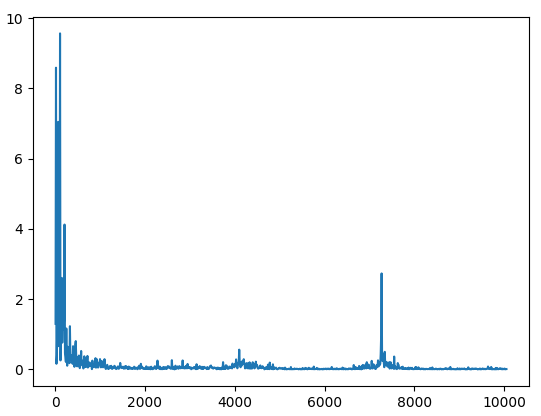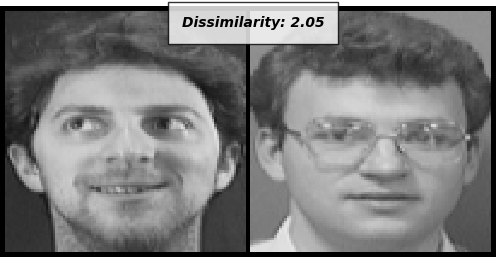pytorch 孪生网络 训练与预测
# coding: utf-8
# # One Shot Learning with Siamese Networks
#
# This is the jupyter notebook that accompanies
# ## Imports
# All the imports are defined here
# In[2]:
#get_ipython().run_line_magic('matplotlib', 'inline')
import torchvision
import torchvision.datasets as dset
import torchvision.transforms as transforms
from torch.utils.data import DataLoader,Dataset
import matplotlib.pyplot as plt
import torchvision.utils
import numpy as np
import random
from PIL import Image
import torch
from torch.autograd import Variable
import PIL.ImageOps
import torch.nn as nn
from torch import optim
import torch.nn.functional as F
# ## Helper functions
# Set of helper functions
# In[3]:
def imshow(img,text=None,should_save=False):
npimg = img.numpy()
plt.axis("off")
if text:
plt.text(75, 8, text, style='italic',fontweight='bold',
bbox={'facecolor':'white', 'alpha':0.8, 'pad':10})
plt.imshow(np.transpose(npimg, (1, 2, 0)))
plt.show()
def show_plot(iteration,loss):
plt.plot(iteration,loss)
plt.show()
# ## Configuration Class
# A simple class to manage configuration
# In[4]:
class Config():
training_dir = "./data/faces/training/"
testing_dir = "./data/faces/testing/"
train_batch_size = 8#64
train_number_epochs = 201#100
# ## Custom Dataset Class
# This dataset generates a pair of images. 0 for geniune pair and 1 for imposter pair
# In[5]:
class SiameseNetworkDataset(Dataset):
def __init__(self,imageFolderDataset,transform=None,should_invert=True):
self.imageFolderDataset = imageFolderDataset
self.transform = transform
self.should_invert = should_invert
def __getitem__(self,index):
tttt = self.imageFolderDataset.imgs
img0_tuple = random.choice(self.imageFolderDataset.imgs)
#we need to make sure approx 50% of images are in the same class
should_get_same_class = random.randint(0,1)
if should_get_same_class:
while True:
#keep looping till the same class image is found
img1_tuple = random.choice(self.imageFolderDataset.imgs)
if img0_tuple[1]==img1_tuple[1]:
break
else:
while True:
#keep looping till a different class image is found
img1_tuple = random.choice(self.imageFolderDataset.imgs)
if img0_tuple[1] !=img1_tuple[1]:
break
img0 = Image.open(img0_tuple[0])
img1 = Image.open(img1_tuple[0])
img0 = img0.convert("L")
img1 = img1.convert("L")
if self.should_invert:
img0 = PIL.ImageOps.invert(img0)
img1 = PIL.ImageOps.invert(img1)
if self.transform is not None:
img0 = self.transform(img0)
img1 = self.transform(img1)
return img0, img1 , torch.from_numpy(np.array([int(img1_tuple[1]!=img0_tuple[1])],dtype=np.float32))
def __len__(self):
return len(self.imageFolderDataset.imgs)
# ## Using Image Folder Dataset
# In[6]: ##########import torchvision.datasets as dset
folder_dataset = dset.ImageFolder(root=Config.training_dir)
# In[7]:
siamese_dataset = SiameseNetworkDataset(imageFolderDataset=folder_dataset,
transform=transforms.Compose([transforms.Resize((100,100)),
transforms.ToTensor()
])
,should_invert=False)
# ## Visualising some of the data
# The top row and the bottom row of any column is one pair. The 0s and 1s correspond to the column of the image.
# 1 indiciates dissimilar, and 0 indicates similar.
# In[8]: ## from torch.utils.data import DataLoader,Dataset
vis_dataloader = DataLoader(siamese_dataset,
shuffle=True,
num_workers=8,
batch_size=8)
dataiter = iter(vis_dataloader)
example_batch = next(dataiter)
concatenated = torch.cat((example_batch[0],example_batch[1]),0)
imshow(torchvision.utils.make_grid(concatenated))
print(example_batch[2].numpy())
# ## Neural Net Definition
# We will use a standard convolutional neural network
# In[9]:
class SiameseNetwork(nn.Module):
def __init__(self):
super(SiameseNetwork, self).__init__()
self.cnn1 = nn.Sequential(
nn.ReflectionPad2d(1),
nn.Conv2d(1, 4, kernel_size=3),
nn.ReLU(inplace=True),
nn.BatchNorm2d(4),
nn.ReflectionPad2d(1),
nn.Conv2d(4, 8, kernel_size=3),
nn.ReLU(inplace=True),
nn.BatchNorm2d(8),
nn.ReflectionPad2d(1),
nn.Conv2d(8, 8, kernel_size=3),
nn.ReLU(inplace=True),
nn.BatchNorm2d(8),
)
self.fc1 = nn.Sequential(
nn.Linear(8*100*100, 500),
nn.ReLU(inplace=True),
nn.Linear(500, 500),
nn.ReLU(inplace=True),
nn.Linear(500, 5))
def forward_once(self, x):
output = self.cnn1(x)
output = output.view(output.size()[0], -1)
output = self.fc1(output)
return output
def forward(self, input1, input2):
output1 = self.forward_once(input1)
output2 = self.forward_once(input2)
return output1, output2
# ## Contrastive Loss
# In[10]:
class ContrastiveLoss(torch.nn.Module):
"""
Contrastive loss function.
Based on: http://yann.lecun.com/exdb/publis/pdf/hadsell-chopra-lecun-06.pdf
"""
def __init__(self, margin=2.0):
super(ContrastiveLoss, self).__init__()
self.margin = margin
def forward(self, output1, output2, label):
euclidean_distance = F.pairwise_distance(output1, output2, keepdim = True)
loss_contrastive = torch.mean((1-label) * torch.pow(euclidean_distance, 2) +
(label) * torch.pow(torch.clamp(self.margin - euclidean_distance, min=0.0), 2))
return loss_contrastive
# ## Training Time!
# In[22]:
train_dataloader = DataLoader(siamese_dataset,
shuffle=True,
num_workers=8,
batch_size=Config.train_batch_size)
# In[23]:
##train
if True:
net = SiameseNetwork().cuda()
criterion = ContrastiveLoss()
optimizer = optim.Adam(net.parameters(),lr = 0.0005 )
# In[24]:
counter = []
loss_history = []
iteration_number= 0
# In[25]:
#train
for epoch in range(0,Config.train_number_epochs):
for i, data in enumerate(train_dataloader,0):
img0, img1 , label = data
img0, img1 , label = img0.cuda(), img1.cuda() , label.cuda()
optimizer.zero_grad()
output1,output2 = net(img0,img1)
loss_contrastive = criterion(output1,output2,label)
loss_contrastive.backward()
optimizer.step()
if i %10 == 0 :
print("Epoch number {}\n Current loss {}\n".format(epoch,loss_contrastive.item()))
iteration_number +=10
counter.append(iteration_number)
loss_history.append(loss_contrastive.item())
if 0 == epoch % 100 and 0 != epoch and 0==i:
torch.save(net.state_dict(),'/media/data_1/Yang/project/2019/project/Facial-Similarity-with-Siamese-Networks-in-Pytorch/Face-Siamese.pt')
show_plot(counter,loss_history)
# ## Some simple testing
# The last 3 subjects were held out from the training, and will be used to test. The Distance between each image pair denotes the degree of similarity the model found between the two images. Less means it found more similar, while higher values indicate it found them to be dissimilar.
# In[28]:
###test
if True:
net = SiameseNetwork().cuda()
net.load_state_dict(torch.load('/media/data_1/Yang/project/2019/project/Facial-Similarity-with-Siamese-Networks-in-Pytorch/Face-Siamese.pt'))
net.eval()
folder_dataset_test = dset.ImageFolder(root=Config.testing_dir)
siamese_dataset = SiameseNetworkDataset(imageFolderDataset=folder_dataset_test,
transform=transforms.Compose([transforms.Resize((100,100)),
transforms.ToTensor()
])
,should_invert=False)
test_dataloader = DataLoader(siamese_dataset,num_workers=6,batch_size=1,shuffle=True)
dataiter = iter(test_dataloader)
x0,_,_ = next(dataiter)
for i in range(10):
_,x1,label2 = next(dataiter)
concatenated = torch.cat((x0,x1),0)
output1,output2 = net(Variable(x0).cuda(),Variable(x1).cuda())
euclidean_distance = F.pairwise_distance(output1, output2)
imshow(torchvision.utils.make_grid(concatenated),'Dissimilarity: {:.2f}'.format(euclidean_distance.item()))

[[1.]
[0.]
[1.]
[0.]
[1.]
[1.]
[0.]
[0.]]
0代表相似,1代表不相似
loss曲线:

测试:




好记性不如烂键盘---点滴、积累、进步!




